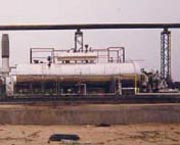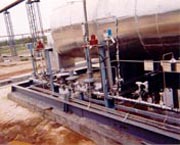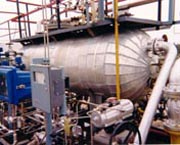Water, Oil and Salt Bath Heaters
Combustion System
The combustion train technology is really the same for either species of heater. There are varieties to consider such as inspirator versus forced draft burner, use of electrics versus instrument gas control, whether a PLC is necessary or whether relays are satisfactory, and other variations which would need to be decided. But the same basic rules apply to both systems.
Vessel Design
The design of the actual fire tube and vessel layout depends on the application. For example, heater-treaters are a lot more complex than water bath heaters and heater-treaters. With respect to the fire tubes of direct crude heaters, special care has to be taken to avoid any hot spots which may vaporize the crude. Therefore when heating crude oil we protect the inlet flame area of the fire tube and monitor the stack temperature to ensure a more consistent heat transfer flux. Heater-treaters also require consideration with respect to vessel internals such as deflection baffles, perhaps an inlet distributor pipe, sand wash facilities and a water withdrawal header.
Gas Release
The crude charge to a crude heater or a heater-treater usually contains a considerable quantity of vapor, which must be separated before entering the Separation Section. Further vaporization occurs because of the pressure drop through the system. It is essential that this vapor be separated prior to moving downstream, since the vapor bubbles formed are saturated with water vapor at the operating temperature.
Gas dissociation section (usually a gas dome or piggy-back degas vessel) in the fire tube section separates the vapors and liquid and maintains a liquid head on the water removal section. This liquid head prevents vaporization downstream.
Operating Temperature
For higher operating temperatures, around 200°C and above, molten salt baths are used with the small bore tubes making up a coil bundle. This produces higher fire tube flux.



